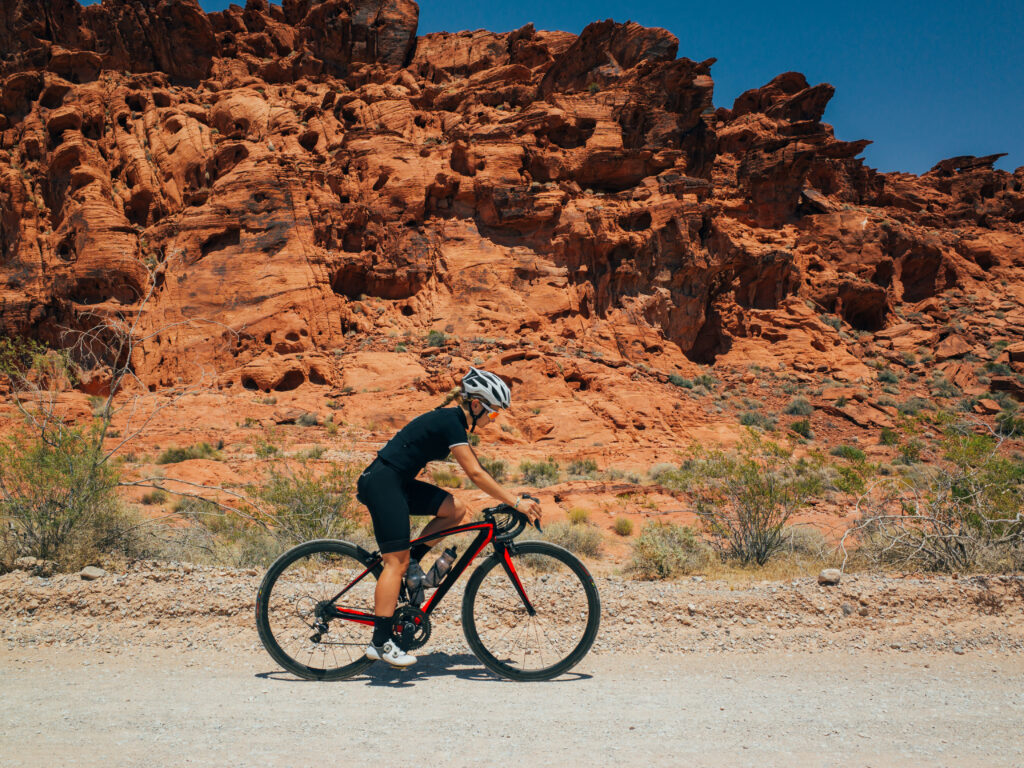Looking to cycle safely on the road? This article provides the 10 rules of the road for road cycling that you need to know. Follow these key guidelines to ensure a safer and enjoyable ride.
Key Takeaways
Wearing a helmet is essential for preventing serious head injuries and is legally required in many states.
Cyclists must use hand signals to communicate their intentions and obey traffic laws to ensure safety on the road.
Staying visible with bright clothing, reflective gear, and lights, as well as using dedicated bike lanes, significantly enhances road cycling safety.
Always Wear a Helmet

Wearing a helmet is crucial for preventing head injuries during a bike ride. Statistics show helmets can reduce serious head injuries by up to 60%, making them an essential part of your cycling gear. Imagine the peace of mind knowing your helmet could be the difference between a minor fall and a life-threatening injury.
Many states require bicyclists to wear helmets by law, underscoring the responsibility to protect yourself. This legal requirement ensures every cyclist is taking necessary precautions. Not wearing a helmet can also lead to fines, adding a financial incentive to stay safer.
Wearing a helmet is simply a smart decision. Accidents can happen to even the most experienced cyclists, and the head is one of the most vulnerable parts of the body. Donning a helmet is a proactive step in ensuring your safety and that of your fellow cyclists.
Use Hand Signals
Communication is key to road safety, and hand signals are vital. Using hand signals allows you to convey your intentions to drivers and other cyclists, reducing the risk of collisions. For instance, to indicate a left turn, extend your left arm straight out. This simple gesture alerts motorists to your movements, helping them anticipate and react during lane changes.
For a right turn, you have two options: extend your right arm straight out or bend your left arm upward at a right angle. To signal that you are slowing down or stopping, extend your left arm downward with your hand open.
These signals are part of the rules of the road and are crucial for avoiding misunderstandings and accidents.
Obey Traffic Signs and Signals
Cyclists share the same rights and responsibilities as motorists, which means adhering to all traffic laws. This includes stopping at stop signs, obeying traffic signals, and yielding the right of way when necessary.
Non-compliance with traffic laws can lead to legal consequences such as fines and citations. More importantly, it significantly increases the risk of accidents. Each year, many cyclists are involved in collisions because they fail to observe these rules. Following traffic regulations helps maintain a predictable flow of traffic, enhancing safety for all road users.
Riding predictably is crucial. When drivers can anticipate your actions, the likelihood of accidents decreases. This includes using hand signals, looking over your shoulder when changing lanes, and making your intentions clear to other road users. These practices keep you safer and foster a cooperative road environment.
Ride in the Same Direction as Traffic
Riding in the same direction as traffic is fundamental for cyclists. It reduces the risk of collisions and makes your movements more predictable to motorists. Riding against the flow of traffic confuses drivers and increases the chances of accidents.
Predictability helps motorists anticipate your actions, making the road safer for everyone. This approach prevents accidents and ensures you are visible and expected on the road.
Riding in the same direction is not just about safety; it’s also about legal responsibility. Cyclists must follow the same traffic laws as motorists, including riding with the flow of traffic in a straight line. This practice aligns with broader principles of road safety and legal compliance.
Stay Visible with Bright Clothing and Lights

Visibility is crucial for bicycle safety. Wearing bright clothing, reflective gear, and using lights can significantly improve your visibility to drivers. Bright colors and reflective materials on your clothing can catch the attention of motorists, especially in low-light conditions.
At night, using lights is essential. A red rear light and a front light can make a huge difference in how well drivers see you. These lights help you see the road ahead and ensure you are seen by others.
In addition to lights and bright clothing, riding in the same direction as traffic increases your visibility. Following the rules of the road makes it easier for drivers to spot you and anticipate your actions, making the road safer for everyone.
Use Dedicated Bike Lanes When Available
Dedicated bike lanes enhance cyclist safety by providing a separate bike lane from motor vehicles. These lanes reduce the risk of injury and improve the overall flow of traffic.
Using bike lanes contributes to better traffic management by giving cyclists a clear area to ride, minimizing conflicts with motor vehicles. This separation makes it easier for both cyclists and drivers to navigate the roads safely.
The presence of bike lanes can encourage more investment in cycling infrastructure, promoting a safer and more bike-friendly environment. Using these lanes, cyclists not only protect themselves but also advocate for better cycling conditions in their communities.
Avoid Riding on Sidewalks
Riding on sidewalks can be dangerous for both cyclists and pedestrians. Cyclists can crash into pedestrians, lose control on uneven surfaces, and surprise drivers who are not expecting them.
Drivers often do not expect cyclists on sidewalks, increasing the risk of accidents when crossing streets or driveways. By avoiding sidewalks and using bike lanes instead, cyclists can ensure a safer environment for everyone.
Be Cautious Around Parked Cars
One common hazard for cyclists is “dooring,” where a parked car door opens unexpectedly into the cyclist’s path. To prevent such incidents, maintain a distance of at least 4 feet from parked cars.
Cyclists should also slow down when approaching parked cars to increase their reaction time and account for blind spots. This extra caution helps avoid sudden accidents and ensures a smoother ride.
Vigilance is key. Always watch for drivers who may open their doors without checking for cyclists. Staying alert and cautious significantly reduces the risk of dooring incidents.
Watch for Road Hazards

Road hazards such as loose gravel, potholes, train tracks, and wet conditions pose significant dangers to cyclists, including the risk of a flat tire. Staying vigilant and scanning the road ahead can help you identify and avoid these obstacles as you cross railroad tracks.
Anticipating hazards and managing your speed appropriately enhances your ability to maintain control. This proactive approach to cycling safety helps navigate hazardous areas without losing balance or control.
Being alert and focused while cycling ensures you can react quickly to unexpected road conditions, keeping you safer from potential crashes and promoting bike riding safety.
Follow the Rules of the Road

Cyclists are legally required to follow the same rules as motor vehicle drivers, including yielding to pedestrians and riding predictably. This includes stopping at stop signs, following traffic signals, and yielding the right of way when necessary.
Riding predictably helps motorists anticipate your actions, reducing the risk of accidents. Cyclists should always ride with the flow of traffic and avoid riding against it to minimize collisions.
Adhering to the rules of the road ensures the safety of cyclists and others, creating a harmonious and safer road environment for all users.
Summary
In summary, following these road cycling safety tips can significantly reduce the risk of accidents and injuries. From wearing a helmet to staying visible with bright clothing and lights, each tip plays a crucial role in ensuring a safer bike ride.
By being proactive and adhering to the rules of the road, cyclists can enjoy their rides while staying safer and protecting themselves and others. Remember, safety is a responsibility shared by all road users.
Frequently Asked Questions
Why is wearing a helmet so important?
Wearing a helmet is crucial as it can reduce serious head injuries by 60%, effectively protecting you while riding. Prioritizing helmet use significantly enhances your safety on the road.
How do I signal a right turn while cycling?
To signal a right turn while cycling, either extend your right arm straight out or bend your left arm upward at a right angle. This clearly communicates your intention to other road users.
Are cyclists required to follow traffic laws?
Yes, cyclists must follow the same traffic laws as motor vehicles, which include stopping at stop signs and obeying traffic signals. Compliance with these regulations is essential for their safety and the safety of others on the road.
Why should I avoid riding on sidewalks?
Avoiding riding on sidewalks is essential as it poses dangers for both cyclists and pedestrians, elevating the risk of collisions and unforeseen accidents. Prioritizing safety is crucial for everyone on the road.
What should I do to avoid dooring incidents?
To avoid dooring incidents, keep a distance of at least 4 feet from parked cars and stay alert for drivers unexpectedly opening their doors. This proactive approach can enhance your safety while cycling or walking.


